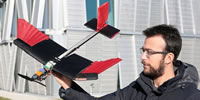Future Drones Will Fly as Silent as Owls, as Steady as Bees
 Glenn McDonald for Seeker: Want to know what drones of the future will look like?
Glenn McDonald for Seeker: Want to know what drones of the future will look like?
So does David Lentink, editor of Interface Focus, a journal that, as its title suggests, looks at the interface of different scientific disciplines. Each issue zeroes in on a particular intersection of physical sciences and life sciences and invites the world's top scholars to publish their latest work.
The latest issue of Interface Focus brings together biologists and engineers to discuss a topic that's relatively straightforward and, well, pretty empirically cool:
"It's completely focused on how animals fly and how that can help us build flying robots," said Lentink, assistant professor of mechanical engineering at Stanford. Can't argue with that.
The new issue features 18 newly published papers on various ways that engineers are borrowing ideas from nature to make the next generation of drones and aerial robots. Several of the papers detail prototype drones that have already been built and tested. Cont'd...
Featured Product

